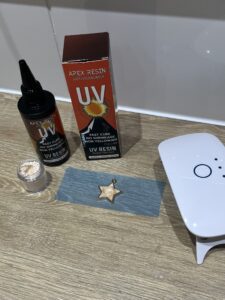What is UV resin?
There’s a huge range of different resins on the market. Epoxy Resin, Eco Resin, UV Resin. But what exactly is UV resin and how can you use it?
UV resin, also known as ultraviolet resin, is a type of liquid resin that cures (hardens) when exposed to ultraviolet (UV) light. It’s often used in various crafting and DIY projects, particularly in jewellery making, model building, and small-scale prototyping.
UV resin typically comes in a one part (no mixing required) liquid form and can be transparent or coloured.
When you apply UV resin to an object or surface, it remains in a liquid state until it’s exposed to UV light. Once exposed to UV light, usually from a UV lamp or sunlight, the resin undergoes a chemical reaction called polymerization, where its molecules link together to form a solid, hardened structure.
What are the advantages of UV resin?
One of the advantages of this type of resin is its quick curing time. Compared to other types of resin, such as epoxy resin, UV resin cures much faster, often within minutes, under the right conditions. This rapid curing time makes it popular for projects that require speedy results.
Is UV resin safe?
Like all resins, it’s important to follow safety precautions when working with UV resin. Every brand will come with its own set of safety instructions which must be followed to ensure your safety. We recommend that you always wear protective gloves and ensure you have proper ventilation in your workspace. You should also use UV light sources responsibly to avoid overexposure and over heating of resin or electrical equipment.
UV resin can stick to most surfaces so we suggest you always cover your work space and clean any spillages as soon as possible.
UV resin v’s epoxy resin
| UV Resin | Epoxy Resin | |
| Mixture | One part – use as needed. No mixing. | Comes in two parts. Needs to be mixed for 3-5 minutes. Can’t be pre-mixed. |
| Curing time | 3-10 minutes (average) via UV Light or Torch. | Varies depending on brand. Ranges from 4-48 hours. |
| Colouring | Can be lightly coloured. Too dark a colour can prevent curing. | Can use opaque or transparent colours. |
| Depth | up to 3cm (this will vary based on brand). | Depending on brand this can be from a few cm up to 40cm. Layering is possible to achieve greater depths. |
| Moulds | Need to use transparent moulds for light to reach right through your resin. | Can use any silicone mould. |
| Durability | High quality brands can be heat resistant and durable. | High quality brands can be heat resistant and durable. |
What do you need to craft with UV resin?
The main things you’ll need are:
- Moulds / pendants
- UV Resin
- UV Lamp / torch
- Resin tape (if not using a mould)
- Protective gloves
- Colour / texture (like glitter or flowers)
We recommend the JDiction UV Resin Starter Kit which contains absolutely everything you could possibly need (and more). It’s often on offer on Amazon too making it really good value for money.
Is UV or epoxy resin better?
We love UV resin because of its really quick curing time and the fact there’s no messy mixing. This makes it great if you don’t have a permanent crafting station and need to tidy away when you finish. You also don’t need to worry about leaving projects curing overnight.
We think UV resin is perfect for making smaller pieces like jewellery and due to its low cost, you can make a relatively decent profit on items quite quickly.
If you’re looking to make bigger projects or add more colour and texture, then epoxy resin is absolutely still worth the effort.




